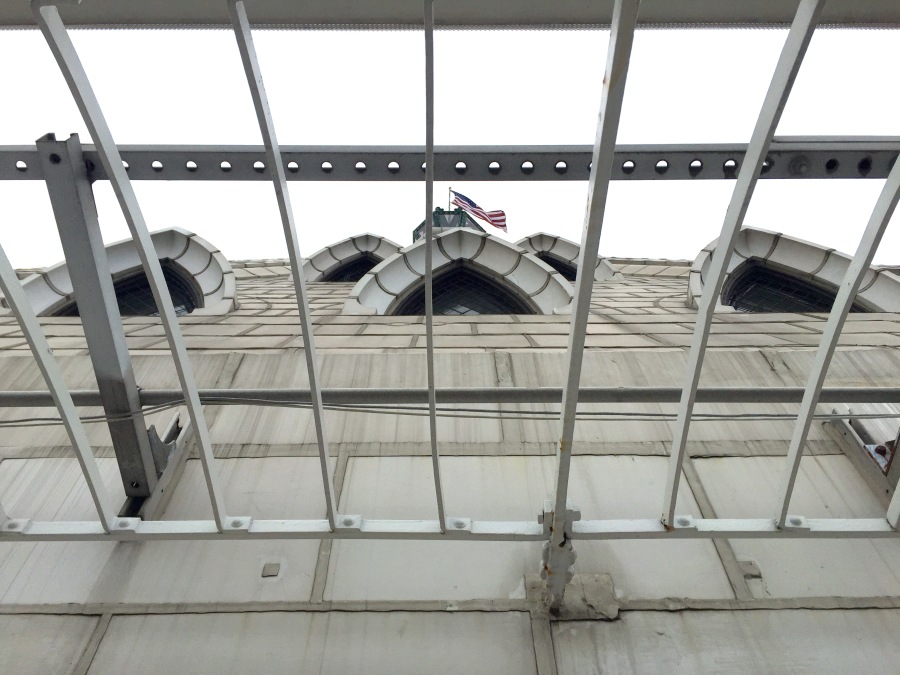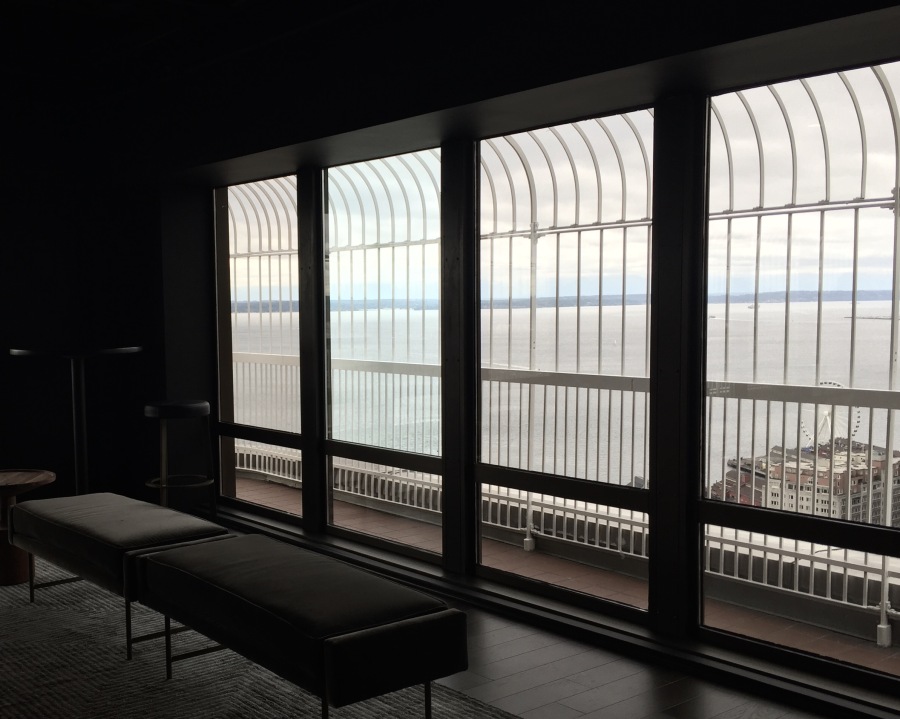Smith Tower has been a recognizable element in the Seattle skyline since its construction. The white tower with a pyramidal top at the southern end of downtown is visible from northbound I-5 as soon as you pass that curve near Boeing field, and from Elliot Bay with its dozens of daily ferries, cruises, and cargo ships. The pyramidal top is particularly eye-catching and rumors circulate about the upper floors of Smith Tower more than any other building in Seattle. What’s up there? The Smith Tower’s 35th floor just reopened to the public and I made the trip this weekend.

Smith Tower was the tallest building in Seattle on its construction in 1914 (see a great photo of it under construction here). It was the first skyscraper constructed by architects Edwin H. and T. Walker Gaggin, and draws from both the New York and Chicago schools of thought. It has the step-backs and dramatic height of a New York skycraper, along with the lightness and functionalism seen in the early skyscrapers in Chicago. Unlike New York and Chicago, it still stands dramatically apart from the majority of Seattle’s other skyscrapers, as downtown’s center as shifted northward since Smith Tower’s construction.
From opening day, Smith Tower offered state-of-the-art high-speed elevators and an observatory floor. The observatory was originally called the Japanese tea room, though it was styled similar to the interior of a Chinese temple (you can see a view of what the Chinese room looked like here).

The observation floor of Smith Tower has been closed since 2014 as it went through remodeling for its centennial. It reopened last week, and visitors are invited through a self-guided tour along the 1st and 2nd floors before being whisked up to the observation floor in one of Smith Towers original (though upgraded!) elevators by a uniformed elevator operator. The self-guided tour is wonderful and cutting-edge in interpretive design, albeit a little light and vague on some of the finer details. Open doors and rooms with minimal barriers laid out in 1920s style invite visitors through spaces and educate on topics like prohibition and early radio broadcasting.
The Chinese room, itself, has been modernized from its previous colorful interior, most notably painted a sleek gray throughout. Some of the original Chinese elements remain, including the intricately carved wood ceiling and a number of the Chinese furniture pieces (which, to my delight, visitors were encouraged to use). The room now displays the cheekily-named Temperance Cafe and Bar, and visitors can walk around the four sides of the observation deck and settle in with a cocktail to take in the view.

So what is in the pyramid above the observation deck? Urban legends circulate about what’s there, but the New York Times published a story and photo collection in 2010 about the residents: a family. The door to the upper floors from the observation room still bears the plaque “private residence.” But believe me, the observation room and the trip up in the elevator (where riders get a glimpse of each floor through the metal grate as the elevator cruises skyward) are well worth the trip.


Read more:
Want to make the trip? You can buy tickets on the first floor of the Smith Tower. You can read more about what they have to offer, here.
I highly recommend the NYT photo collection “Who Lives There: The Pyramid Atop Seattle’s Smith Tower.”
The Seattle Times published an interesting historical timeline of the Smith Tower this June.
History Link has an article about the Smith Tower that can be found here. This article includes a number of historic images.





That is one stunning building…and the story to go along with it! Great read.
LikeLike
Thank you! Definitely a beautiful building. I love that so much of the historic elements, like the elevators, are still intact!
LikeLiked by 1 person
Thank you so much for taking the tour on behalf of the curious (like me!) I was a little shocked that they did away with the Chinese Room theme but I guess it was never landmarked. Then they kept the ceilings and the wishing chair? I guess this works OK with the Prohibition theme? I am architecturally confused but the Fifth Avenue Theater is that way, too…..some sort of Chinese theme but some other stuff…..I guess…..Well, actually I am just glad that the new owners seem to be committed to doing the needed maintenance and upgrades of our beloved Smith Tower.
LikeLike
I agree it’s just exciting and refreshing to have an owner that is so eager to keep the historic character. The Chinese Room has a nice display on one wall about its history, which is great. The ceiling is spectacular, I’m so glad it’s intact! The wishing chair is there, along with several furniture pieces and other historic items. The only thing I’m on the fence about is the walls, which seem very dark. It does, however, draw your eyes to the ceiling and out the windows! It might be best on darker cloudier days, which we have so much of here in Seattle. Over-all a job well done!
LikeLiked by 1 person
Since they didn’t ask us before they redecorated it……..What can we say?
LikeLike
Haha! It’s true! 🙂
LikeLiked by 1 person
Very nice! I looked at all the photos linked in here. Particularly enjoyed pictures of the apartment at the top. D
>
LikeLike
Thanks! The pictures from the apartment in the pyramid are fantastic. I definitely want to see it, myself! 🙂
LikeLike
Great details–especially the elevator hardware! Thanks for sharing.
LikeLike
Thank you! Yes, the elevators in particular are fantastic!
LikeLiked by 1 person
The slate gray paint really ruins what should be a great room. The previous Chinese Room decor was light, airy, happy, exactly what is needed at the top floor of a skyscraper in an often gray place. The Chinese Room now just looks like a cave, entirely incongruous and inappropriate for a skyscraper observatory.
I do not understand the current obsession with painting everything in various depressing grays, though as an architectural historian, I know there are past examples of similar eras. Antebellum Greek Revival parlors, notably, were painted in such austere grays that even today’s gray-loving, myopic, and ignorant modernists would applaud them for having such good taste in design.
LikeLike
I agree, and they choose such a dark gray as well. Painting brick walls gray seems to also be a trend–even worse! I was so pleased that they kept the carved ceiling intact, I gave them a break on the walls, but hopefully they rethink their decision. It would be interesting to see the various different looks these walls have gone through over the years, I’m sure the space changes drastically with different paint/wallpaper. And it is certainly less of a Chinese Room with the dark gray walls.
LikeLike
[…] been admiring Smith Tower from afar since the day I moved to Seattle. I’m so glad they finally reopened their […]
LikeLike